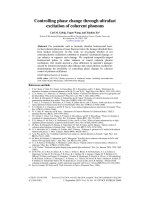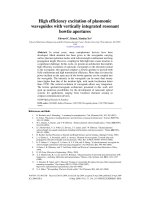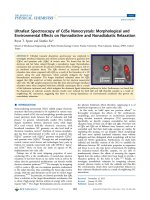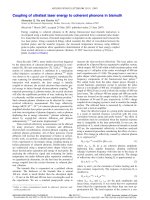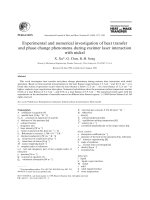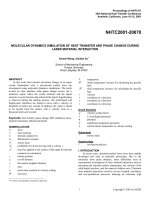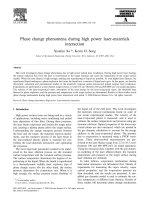controlling phase change through ultrafast excitation of coherent phonons
Bạn đang xem bản rút gọn của tài liệu. Xem và tải ngay bản đầy đủ của tài liệu tại đây (1.41 MB, 7 trang )
Controlling phase change through ultrafast
excitation of coherent phonons
Carl M. Liebig, Yaguo Wang, and Xianfan Xu*
School of Mechanical Engineering and Birck Nanotechnology Center, Purdue University,
West Lafayette, IN 47907, USA
*
Abstract: For semimetals such as bismuth, ultrafast femtosecond laser-
excited coherent phonons at laser fluences below the damage threshold have
been studied extensively. In this work, we investigate whether or not
coherent phonon oscillations contribute to material’s permanent damage, or
can enhance or suppress such damage. We employed temporally-shaped
femtosecond pulses to either enhance or cancel coherent phonon
oscillations. Our results showed a clear difference in material’s damages
caused by femtosecond pulses that enhance and cancel phonon oscillations,
demonstrating the possibility of controlling phase changes by coherent
control of phonon oscillations.
©2010 Optical Society of America
OCIS codes: (320.7130) Ultrafast processes in condensed matter, including semiconductors;
(320.7120) Ultrafast Phenomena; (320.5540) Pulse Shaping.
References and links
1. T. K. Cheng, J. Vidal, H. J. Zeiger, G. Dresselhaus, M. S. Dresselhaus, and E. P. Ippen, “Mechanism for
displacive excitation of coherent phonons in Sb, Bi, Te, and Ti
2
O
3
,” Appl. Phys. Lett. 59(16), 1923–1925 (1991).
2. G. A. Garrett, T. F. Albrecht, J. F. Whitaker, and R. Merlin, “Coherent THz Phonons driven by Light pulses and
the Sb problem: What is the mechanism?” Phys. Rev. Lett. 77(17), 3661–3664 (1996).
3. M. Hase, K. Mizoguchi, H. Harima, S. Nakashima, and K. Sakai, “Dynamics of coherent phonons in bismuth
generated by ultrashort laser pulses,” Phys. Rev. B 58(9), 5448–5452 (1998).
4. T. Garl, E. G. Gamaly, D. Boschetto, A. V. Rode, B. Luther-Davies, and A. Rousse, “Birth and decay of coherent
optical phonons in femtosecond-laser-excited bismuth,” Phys. Rev. B 78(13), 134302 (2008).
5. E. S. Zijlstra, L. L. Tatarinova, and M. E. Garcia, “Laser-induced phonon-phonon interactions in bismuth,” Phys.
Rev. B 74(22), 220301 (2006).
6. W. A. Kütt, W. Albrecht, and H. Kurz, “Generation of Coherent Phonons in Condensed Media,” IEEE J.
Quantum Electron. 28(10), 2434–2444 (1992).
7. H. J. Zeiger, J. Vidal, T. K. Cheng, E. P. Ippen, G. Dresselhaus, and M. S. Dresselhaus, “Theory for displacive
excitation of coherent phonons,” Phys. Rev. B Condens. Matter 45(2), 768–778 (1992).
8. É. D. Murray, D. M. Fritz, J. K. Wahlstrand, S. Fahy, and D. A. Reis, “Effect of lattice anharmonicity on high-
amplitude phonon dynamics in photoexcited bismuth,” Phys. Rev. B 72(6), 060301 (2005).
9. M. Hase, K. Mizoguchi, H. Harima, S. Nakashima, M. Tani, K. Sakai, and M. Hangyo, “Optical control of
coherent optical phonons in bismuth films,” Appl. Phys. Lett. 69(17), 2474–2476 (1996).
10. O. V. Misochko, M. V. Lebedev, H. Schäfer, and T. Dekorsy, “Coherent A
1
phonons in Te studied with tailored
femtosecond pulses,” J. Phys. Condens. Matter 19(40), 406220 (2007).
11. A. Q. Wu, and X. Xu, “Coupling of ultrafast laser energy to coherent phonons in bismuth,” Appl. Phys. Lett.
90(25), 251111 (2007).
12. M. Hase, M. Kitajima, S. Nakashima, and K. Mizoguchi, “Forcibly driven coherent soft honons in GeTe with
intense THz-rage pump fields,” Appl. Phys. Lett. 83(24), 4921 (2003).
13. C. A. D. Roeser, M. Kandyla, A. Mendioroz, and E. Mazur, “Optical control of coherent lattice vibrations in
tellurium,” Phys. Rev. B 70(21), 212302 (2004).
14. A. M. Weiner, “Femtosecond pulse shaping using spatial light modulators,” Rev. Sci. Instrum. 71(5), 1929–1960
(2000).
15. D. M. Fritz, D. A. Reis, B. Adams, R. A. Akre, J. Arthur, C. Blome, P. H. Bucksbaum, A. L. Cavalieri, S.
Engemann, S. Fahy, R. W. Falcone, P. H. Fuoss, K. J. Gaffney, M. J. George, J. Hajdu, M. P. Hertlein, P. B.
Hillyard, M. Horn-von Hoegen, M. Kammler, J. Kaspar, R. Kienberger, P. Krejcik, S. H. Lee, A. M. Lindenberg,
B. McFarland, D. Meyer, T. Montagne, É. D. Murray, A. J. Nelson, M. Nicoul, R. Pahl, J. Rudati, H. Schlarb, D.
P. Siddons, K. Sokolowski-Tinten, Th. Tschentscher, D. von der Linde, and J. B. Hastings, “Ultrafast bond
softening in bismuth: mapping a solid’s interatomic potential with X-rays,” Science 315(5812), 633–636 (2007).
16. See for example: M. Born, and E. Wolf, Principles of Optics, (Pergamon Press, 1980).
#132059 - $15.00 USD
Received 21 Jul 2010; revised 2 Sep 2010; accepted 2 Sep 2010; published 10 Sep 2010
(C) 2010 OSA
13 September 2010 / Vol. 18, No. 19 / OPTICS EXPRESS 20498
17. J. M. Liu, “Simple technique for measurements of pulsed Gaussian-beam spot sizes,” Opt. Lett. 7(5), 196–198
(1982).
18. K. Sokolowski-Tinten, C. Blome, J. Blums, A. Cavalleri, C. Dietrich, A. Tarasevitch, I. Uschmann, E. Förster,
M. Kammler, M. Horn-von-Hoegen, and D. von der Linde, “Femtosecond X-ray measurement of coherent lattice
vibrations near the Lindemann stability limit,” Nature 422(6929), 287–289 (2003).
19. G. Sciaini, M. Harb, S. G. Kruglik, T. Payer, C. T. Hebeisen, F J. M. Heringdorf, M. Yamaguchi, M. H
Hoegen, R. Ernstorfer, and R. J. D. Miller, “Electronic acceleration of atomic motions and disordering in
bismuth,” Nature 458(7234), 56–59 (2009).
1. Introduction
The ability to generate optical pulses shorter than the period of phonon vibration allows for
investigations of coherent phonons in certain materials, particularly in semimetals such as
bismuth [1–8]. The mechanism responsible for generating coherent phonons in opaque
materials is the displacive excitation of coherent phonons (DECP) [1,2]. DECP describes
exciting a large population of valence electrons to the anti-bonding conduction band, shifting
the equilibrium positions of the crystal lattice, and causing atoms to vibrate around the new
equilibrium position.
In this study, we investigate the effect of coherent phonon oscillation on permanent
damage in bismuth. A number of studies have shown by using double-pulse excitation, the
amplitude of coherent phonon oscillation can be controlled in various materials [9–11], and it
was demonstrated that such coherent phonon control can be realized at laser fluences near the
damage threshold [12,13]. In our earlier work, double-pulses with different pulse separation
times were used to control the coherent phonon amplitude and determine the amount of
energy coupled into the coherent phonon oscillation [11]. In this work, we use a temporal
pulse-shaping technique to synthesize two-pulse and four-pulse pulse trains. Our objective is
to control material’s damage through resonantly enhancing or suppressing coherent phonon
oscillations. The effect of coherent oscillations is analyzed by comparing material damages
when coherent oscillations are enhanced or cancelled.
2. Experimental setup
The sample used in this study was a 100 nm thin-film of Bi evaporated onto a polished silicon
substrate. The thickness of the film is considerably larger than the penetration depth of 800
nm and 400 nm light used in this work, which are approximately 24 nm and 15 nm
respectively. The experimental setup was a collinear two-color pump-probe setup. The laser
source was a Spectra-Physics Spitfire regenerative amplifier system, which produces 50 fs
full-width half-maximum pulses with energies up to 200 µJ at a repetition rate of 5 kHz. The
pump pulse was shaped through amplitude and phase modulation using a double 128-pixel
liquid crystal spatial light modulator [14]. The frequency of the shaped pump pulse was
doubled. The collinear 400 nm pump and 800 nm probe beams were focused onto the sample
using a 10 cm focal length lens. The 1/e Gaussian contour diameters of the pump and probe
pulses are 14.5 µm and 6.1 µm respectively. The reflected probe beam was collected using a
balanced photodetector and a lock-in amplifier.
To control coherent phonon oscillations and to determine their effects on damage, pulse
trains consisting of two and four pulses were designed using the pulse-shaper discussed
above. When the separation time between the incident pulses matches the period of the
phonon oscillation, the amplitude of coherent phonons was enhanced, whereas phonon
oscillations were cancelled when the incident pulse separation corresponds to half orders of
the phonon period. Due to phonon softening that occurs with increased excitation fluences, it
is necessary to customize the pulse separation times for individual laser fluences. It has also
been found necessary to use different pulse energy ratios in the pulse train to cancel the
phonon oscillation as the vibrations decay over the time span of the pulse separations [11]. In
this study, the same pulse energy ratios were used for both the pulses designed to enhance and
cancel phonon oscillations at a given total laser fluence.
#132059 - $15.00 USD
Received 21 Jul 2010; revised 2 Sep 2010; accepted 2 Sep 2010; published 10 Sep 2010
(C) 2010 OSA
13 September 2010 / Vol. 18, No. 19 / OPTICS EXPRESS 20499
3. Results and discussion
We first discuss the results for characterizing the effects of pulse shapes on coherent phonon
oscillations and for ensuring that the synthesized pulse trains can indeed enhance or cancel
phonon oscillation. Figure 1(a) shows the change in reflectivity as a function of time for
single pulse excitation with a fluence of 1.2 mJ/cm
2
. Figures 1(b) and 1(c) show the results
using double-pulse pulse train excitation for a total fluence of 1.2 mJ/cm
2
. The arrows along
the abscissa indicate the arrival of the excitation pulses. From Figs. 1(b) and 1(c), it can be
seen that by controlling the delay time and energy ratio between the excitation pulses, the
amplitude of the coherent phonon oscillations can be enhanced or cancelled. Figures 1(d) and
1(e) show the results when excited with four-pulse pulse trains, again with a total fluence of
1.2 mJ/cm
2
. For
-2
0
2
4
6
8
0 2 4 6 8 10
∆R/R
0
( x10
-3
)
Delay (ps)
(a)
-2
0
2
4
6
8
0 2 4 6 8 10
∆R/R
0
( x10
-3
)
Delay (ps)
(b)
-2
0
2
4
6
8
0 2 4 6 8 10
∆R/R
0
( x10
-3
)
Delay (ps)
(c)
-2
0
2
4
6
8
0 2 4 6 8 10
∆R/R
0
( x10
-3
)
Delay (ps)
(d)
-2
0
2
4
6
8
0 2 4 6 8 10
∆R/R
0
( x10
-3
)
Delay (ps)
(e)
∆R/R
0
( x 10
-
3
)
Time (ps)
Fig. 1. Single pulse (a), double-pulse (b),(c) and four-pulse (d),(e) pump-probe measurements
of reflectivity in bismuth. Shaped pulses were designed to enhance (b)(d) and cancel (c)(e)
coherent phonon oscillations. The total incident fluence used in these measurements was 1.2
mJ/cm
2
. The arrows along the x-axis show the arrival of the excitation pulses. For the double-
pulse excitation, the peak amplitudes normalized to that of the first pulse are 1.0 and 0.5. For
the four-pulse excitation, the peak amplitudes normalized to that of the first pulse are 1.0, 0.46,
1.05, and 0.7. The separation times between the consecutive pulses in Fig. 1(d) are δT, 2δT,
and δT, and 1.5δT, δT, and 1.5δT in Fig. 1(e), where δT is the phonon oscillation period.
Figure 1(e), the second pulse was designed to cancel phonon oscillations generated by the
first pulse, and the fourth pulse to cancel oscillations generated by the third pulse. The
separation times between the consecutive pulses in Fig. 1(d) are δT, 2δT, and δT, and in
Fig. 1(e) are 1.5δT, δT, and 1.5δT (δT is the phonon oscillation period). Therefore, the total
time durations are the same between the first pulse and the fourth pulse for the two cases.
For 800 nm excitation, bismuth reaches the thermal melting temperature of 544 K when
excited by a single pulse with a fluence of ~1.5 mJ/cm
2
, but requires a fluence of ~4.1 mJ/cm
2
to melt due to the latent heat of fusion [15]. Using the melting threshold value at 800 nm and
accounting for the difference in absorption using Fresnel’s equations [16], the melting
threshold at 400 nm is calculated to be approximately 2.6 mJ/cm
2
. Figure 2(a) shows pump-
probe measurement for single pulse excitation of bismuth at a fluence above the melting
#132059 - $15.00 USD
Received 21 Jul 2010; revised 2 Sep 2010; accepted 2 Sep 2010; published 10 Sep 2010
(C) 2010 OSA
13 September 2010 / Vol. 18, No. 19 / OPTICS EXPRESS 20500
threshold for both short (inset) and long delay times. The arrow indicates the lowest
reflectivity, representing the highest temperature reached in the process since the reflectivity
of bismuth has a negative temperature coefficient [11]. Figure 2(b) shows the lowest
reflectivity as a function of fluence. The lowest reflectivity changes almost linearly with the
laser fluence. Similar results have also been observed when bismuth was excited above the
melting threshold [4].
Fig. 2. (a) Pump-probe measurements for fluence of 3.1 mJ/cm
2
for long and (inset) short delay
times. The arrow shows the time when the lowest reflectance or highest temperature is
obtained. (b) The minimum reflectivity as a function of laser fluence.
The laser fluence required to cause permanent damage using a single 400 nm pulse is
about 14 mJ/cm
2
(see below). At laser fluences above the melting threshold and up to the
single-shot damage threshold, coherent oscillations can still occur in the first few picoseconds
due to the time required to transfer energy from electrons to the lattice. The effect of phonon
oscillations at these higher fluences on materials damage was investigated in this work. The
damaged areas produced by 5,000 pulses were measured. Using 5,000 pulses instead of single
pulse allows determination of the damage areas more accurately. Figure 3 shows the multi-
pulse damage area as a function of laser fluence for 5,000 (a) double-pulse and (b) four-pulse
excitation designed to enhance and cancel coherent phonon oscillations. It is seen that for both
cases, the damage areas caused by enhanced phonon oscillations are larger than those when
phonon oscillations are suppressed. An example of surface optical image produced by phonon
enhancement and phonon cancellation with a total laser fluence of about 7 mJ/cm
2
is shown in
Fig. 3(c). Experiments were repeated in each case (six times each shown in the figure) to
ensure reproducibility of the results. The image shows a clear difference in the size of the
damaged area between phonon enhancement and phonon cancellation. Also, the damaged area
appears darker with phonon enhancement compared with that produced with phonon
cancellation.
#132059 - $15.00 USD
Received 21 Jul 2010; revised 2 Sep 2010; accepted 2 Sep 2010; published 10 Sep 2010
(C) 2010 OSA
13 September 2010 / Vol. 18, No. 19 / OPTICS EXPRESS 20501
Fig. 3. Area of visible damage as a function of the incident pulse fluence for 5,000 (a) double-
pulse and (b) four-pulse pulse trains designed to enhance and cancel coherent phonon
oscillations. For the double-pulse, the normalized pulse amplitudes were 1.0 and 0.15 with a
pulse separation of 406 fs for enhancement and 610 fs for cancellation. For the four pulse
measurements the normalized pulse amplitudes were 1.0, 0.15, 1.0 and 0.15. For double-pulse
excitation a minimum total fluence of 3.15 mJ/cm
2
and 3.85 mJ/cm
2
for enhancement and
cancellation of phonon oscillations, respectively and for four-pulse excitation a minimum total
fluence of 5.86 mJ/cm
2
and 6.33 mJ/cm
2
for enhancement and cancellation of phonon
oscillations, respectively. (c) Optical image of surface damage produced by double-pulses for
phonon enhancement (column 1 and 3) and phonon cancellation (column 2 and 4). The total
laser fluence is about 7 mJ/cm
2
.
The damage regression method [17] was used to extract the minimum fluence required for
damage. Due to the Gaussian intensity profile of the incident beam, the damaged area
increases with the natural logarithm of the total pulse fluence. When plotted on a semi-log
scale, the minimum fluence required for damage can be extrapolated as the x-intercept of the
fitted line. It was found for double-pulse excitation, the minimum total fluence required for
damage with 5,000 pulses was 3.2 mJ/cm
2
for phonon enhancement and 3.9 mJ/cm
2
for
#132059 - $15.00 USD
Received 21 Jul 2010; revised 2 Sep 2010; accepted 2 Sep 2010; published 10 Sep 2010
(C) 2010 OSA
13 September 2010 / Vol. 18, No. 19 / OPTICS EXPRESS 20502
phonon cancellation. For four-pulse excitation, a total laser fluence of 5.9 mJ/cm
2
wasneeded
to damage for phonon enhancement and 6.3 mJ/cm
2
was needed for phonon cancellation. The
difference in the fluence required between the double-pulse and four-pulse excitation can be
caused by the differences in the fluences of the individual pulses - the fluences of the
individual pulses in the two-pulse pulse train are higher. In addition, the four-pulse excitation
allows phonon oscillations to increase over the duration of the pulse train, but does not excite
the same maximum phonon amplitude compared with two-pulse excitation as seen in Fig. 1.
The differences in the damage area and the minimum fluence for damage when the
coherent phonon oscillations are enhanced and cancelled are indicative of the effect of the
coherent phonons on materials phase change. From a phenomenological point of view,
amplifying phonon oscillations decreases the stability of the lattice and assists phase change.
Results shown in Fig. 3 provide experimental evidence that coherent control of phonon
oscillation can affect material’s damage.
Fig. 4. Pump-probe measurements for fluences of (a) 11.3 mJ/cm
2
and (b) 15.6 mJ/cm
2
at
excitation wavelength of 400 nm. Although excited at fluences close to and above the single
shot damage threshold, rapidly dephasing oscillations are still visible.
We would like to point out that recent measurements using X-ray and electron diffraction
have shown when the single pulse fluence is higher than 23 mJ/cm
2
at 800 nm excitation,
“non-thermal’ melting occurs at about 200 fs, faster than the coherent phonon oscillation
period [18,19]. This fluence corresponds to ~14 mJ/cm
2
at 400 nm. For four-pulse pulse trains
used in Fig. 3, the laser fluences of individual pulses are all below 14 mJ/cm
2
. For double-
pulse pulse trains, the fluence of the first pulse can be around or slightly above 14 mJ/cm
2
for
the highest fluences used in Fig. 3 as the ratio of the first to second pulse was about 6:1, yet
the phonon oscillations affect the material’s damage. Phonon oscillations near and above 14
mJ/cm
2
were observed in our optical measurements. Figure 4 shows measurement results of a
single 400 nm pulse excitation with a fluence of (a) 11.3 mJ/cm
2
and (b) 15.6 mJ/cm
2
. (Since
the laser fluence is close to and exceeds the single shot damage threshold, it was necessary to
translate the sample during the measurement.) In our measurements, we found evidences of
oscillations beyond 200 fs at fluences where “non-thermal” melting is expected. One possible
reason is that in Refs. 18 and 19, the experiments were performed using thinner bismuth films
#132059 - $15.00 USD
Received 21 Jul 2010; revised 2 Sep 2010; accepted 2 Sep 2010; published 10 Sep 2010
(C) 2010 OSA
13 September 2010 / Vol. 18, No. 19 / OPTICS EXPRESS 20503
(30 nm and 50 nm) whereas in our experiments, a 100 nm-thick film was used. The thicker
film in our work allows hot carriers to diffuse further away from the surface, therefore
lowering the surface temperature and increasing the damage threshold.
4. Conclusions
In conclusion, we show that by using temporally shaped femtosecond pulse trains, we are able
to control the coherent phonon oscillations in bismuth. When the pulse-to-pulse frequency of
the incident pulses matches the oscillation frequency of the coherent phonons thus enhancing
the amplitude of phonon oscillations, there is more damage than when the pulses cancel
phonon oscillation. Therefore, controlling the coherent phonon oscillation has a direct effect
on the amount of damage in materials such as bismuth.
Acknowledgments
Support for this work by the Air Force Office of Scientific Research (AFOSR) (FA9550-08-1-
0091) and the Sandia National Laboratory (No. 620550) are gratefully acknowledged. We
would also like to thank Dr. Daniel E. Leaird for his insightful discussion on pulse shaping
and Lin Zhao, Pornsak Srisungsitthisunti and Sreemanth Uppuluri for optical damage
measurements.
#132059 - $15.00 USD
Received 21 Jul 2010; revised 2 Sep 2010; accepted 2 Sep 2010; published 10 Sep 2010
(C) 2010 OSA
13 September 2010 / Vol. 18, No. 19 / OPTICS EXPRESS 20504
